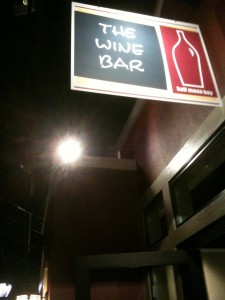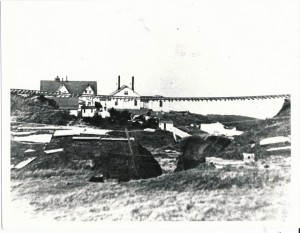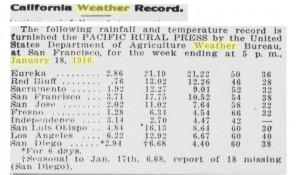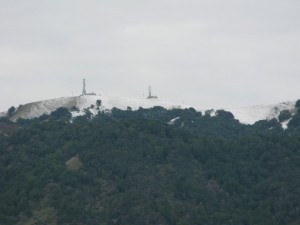Story by John Vonderlin
Email John ([email protected])
Hi June,
This travelogue was published in the December 10, 1887 issue of the ‘Pacific Rural Press.” Just about every Coastside notable person I know of from this time and a few new ones are mentioned. This is the first time I have read a description of the location of the mysterious “Singing Sand Beach” of Pescadero. Based on his directions it would be at Fiddler’s Cove, just north of Pescadero Point. However, as there is no two mile long beach there, and he says he didn’t have time to visit it, I can’t be sure. Enjoy. John
On the Coast of San Mateo County.
Editors Press: —It was with some reluctance that your correspondent turned his back upon the charming rural scenes of Woodside, where he was so pleasantly entertained at the residence of Mr. John Winkler, on the night of the 18th inst., but a sense of duty in the interest of your journal impelled him to take leave early on the following morning. Following down the Palarcitos (sic) creek several miles, I observed many orchards and vineyards, which gave evidence of skillful culture and bountiful returns for the outlay, though planted at but comparatively recent date. Finally, when within six miles of Half Moon Bay, more familiarly known as Spanish Town, I cross a low range of mountains and drop into a beautiful fertile valley, and am soon in the midst of a population of about 900 people. Half Moon Bay has an ancient appearance, many of the buildings being moss-grown with age. The inhabitants anxiously yearn for railway connection with San Francisco, and are confident that such an accomplishment is all that is required to make it one of the most prosperous communities in the State. The soil is extremely fertile, and the climate, barring occasional fog, is most inviting, and there is no doubt that with an outlet by rail communication, many would seek homes here in preference to places they now occupy. At present, the hopes of the people are encouraged with the promise of a coast wagon-road, by which the distance to your city will be reduoed from 34 to only 18 miles. On Saturday night I drove six miles up the Half Moon Bay, and stopped over Sunday with Mr. J. F. Weinkie, proprietor of the Moss Beach House. Here we found good treatment, and readily became convinced that the place has many attractions for those seeking rest and recreation from the bustling scenes incident to city life. Opportunities for bathing, boating, and fishing are scarcely excelled anywhere, and guests may rest assured that the proprietor will spare no pains to make them comfortable at most reasonable rates. Contrary to expectation, based upon information regarding the inhabitants of Half Moon Bay, many of whom are of foreign birth and uneducated in our language, I succeeded in extending the circulation of the Press considerably. Among those worthy of special mention on account of their enterprise and public spirit the names of R. J. Knapp, manufacturer of the premium side-hill plows; Levy Bros., merchants; Wm. Pringle, harness-maker, as well as others whose names we cannot now recall, are conspicuous. On Tuesday morning following we proceeded along the coast, passing through a beautiful district of productive farming lands, extending from the water’s edge to the mountain tops, much more of which was cultivated in former years than at present. In earlier times the certainty of orops regardless of rainfall along the coast, together with the high prices of grain, was an incentive for the cultivation of extensive tracts to grain. Now all is changed. Other sections of the State, though far less productive and certain for crops, have on aocount of railroad connection with the outside world superseded this region in the grain-raising industry, and the country is now devoted principally to the dairy business. Six miles down the coast I arrive at Purissima, a small village, though graced with a few good residences, among which is that of Henry Dobble, and a creditable school building. Further on we pass the thrifty farms of Andrew Osterman, John Schleef, and at noon we accept the hospitalities of H. Friy and family. Mr. Friy here owns a good farm of over 300 acres well improved and stocked with fine cattle, horses and hogs. He shows a colt, McLellan stock, but two years old, whioh measures 16 hands and weighs over 1000 pounds. Proceeding along the coast, the first raindrops of the season commenced to fall, and I concluded to raise the top of my buggy. Soon after doing so all indications of rain vanished. Notwithstanding that less rain is required along the coast than inland, it would prove a most welcome visitor. Dairymen are compelled to depend upon hay, pumpkins and beets principally to maintain their herds until new grass comes, which oannot grow without rain.
Passing up San Gregorio creek five miles, I halt in front of J. W. Bell’s residence and pass a pleasant night with the proprietor and his kind companion. Mr. Bell has an excellent farm here —very productive —but he finds dairying more profitable than any other branch of rural life. William Watkins, one mile above, has also a fine scope of land well adapted to fruit-growing and for the production of grain and vegetables. Though the oountry along the oreek is somewhat rugged, yet on account of the excellent land, pure water and romantic surroundings the section has many attractions for those who have a taste for oountry homes. Wednesday night I spent at the homestead of R. H. Brown, Esq., I 1/2 miles north of Pesoadero. This is a model dairy-ranoh of 1250 acres. He keeps 160 head of cows, from whioh he makes an average of one pound of butter per day to eaoh animal. Arriving in the town of Pescadero on Thanksgiving Day, I was pleased to find it so pleasantly situated between Pescadero and Butano creeks. The streets are regular and wide, and, though the place boasts
of no extremely costly buildings, the residences of many denote taste and thrift. Pescadero, it is claimed, was 20 years ago one of the most lively towns of its size on the coast. Many large sawmills, which have ceased operations, employed many men; besides, farming and gardening in those days employed much help. But long sinoe the land-owners have turned their attention to dairying and stock-raising, which requires but a limited amount of laborers. As a consequence, the solitude of the place is almost painful at times, and is only occasionally broken by the visit of a traveling agent canvassing for books, newspapers, etc., or a company of tourists, for whioh the vicinity affords solid attractions. One mile below the town is a beach, two miles in length, of singing sand. The singing sand-beach of Manchester, Mass., was formerly supposed to be the only one in the world. I had not the time to spare to pay the beach a visit, but was authentically informed that the music arising from the sand when treading over it is similar to that of the sound produced by walking upon hard, frozen snow. There are also pebble and agate beaches near the town, where are found opals, agate, carnelian, onyx, turquoise and many other precious stones. There is fine hunting and fishing in the neighborhood. The redwoods lay but a short distance to the rear, and taken all in all, it can well be claimed that in seeking a resort, Pescadero should not be wholly overlooked. Those visiting the place will find two hotels, the Swanton house and the Pescadero house. The former is long established, while the latter is new and newly refitted. The proprietor, Mr. Jno. McCormick, seems specially adapted to the position he holds, and spares no pains to make his guests comfortable at very reasonable rates. Mr. Chas. Wm. Swanton, who had owned and managed the Swanton house for 26 years, died on the 23d inst., and was buried under the auspices of the Masonic fraternity, of which he was a worthy member, on the 25th inst. The obsequies brought together a large number of people for miles around to pay homage to one they highly respected and esteemed. The town and vicinity boasts of a number of men whom it is not only an honor but a pleasure to know. Among these are B. V. Weeks, Esq., dairyman; Mr. Alex. Moore, one of the oldest settlers of Pescadero, owner of a large tract of land, and is engaged in dairying and fruitgrowing. Eli D. Moore, his son, is distinguished as having been the first white male born in California, the date of his birth being Deo. 12, 1847. Mr. M. has been a constant reader of the Rural Press sinoe the first day it was published and still “staya with it.” Pescadero is well represented by fraternal societies as well as the other concomitants of civilization, such as schools and ohurches. The Masonic Order has long been established and is in a prosperous condition. The Odd Fellows have a thriving Lodge of 41 members. Their Noble Grand is Mr. Henry Dearborn, and secretary, A. G. Ghoulson. The Druids boast of a membership of 35, with Mr. A. C. Maxey, N. A., and A. Levy, secretary. Saturday morning I wended southward along the coast and by evening found myself in front of the pleasant home of I. C. Steele, Esq., where I was courteously received and entertained until Monday morning, when I was reminded that another week’s experience of travel lay before me, and I must gird on the armor of battle. Before taking leave of our host and his estimable family, a few observations regarding the lovely homestead they occupy may not be out of place. Mr. Steele’s south line runs within a short distance of the northern boundary of Santa Cruz county. Looking to the westward from the site of his residence there stretches out before our eyes a large scope of grazing lands, while just beyond may be seen the foaming waters of the Pacific, whose roar, though some miles distant, may be plainly heard every hour. Gazing eastward, a magnificent panorama is thrust upon our vision. The evergreen Coast Range presents a beautiful contrast with the brown hills that intervenes between them and the Pacific ocean. The comfortable residence, fine gardens of flowers, vegetables and fruits of nearly every variety known to our soil and climate, the pastures stocked with some of the finest cattle and horses in the State, large and commodious buildings for every requirement, including barns and dairy buildings for the prosecution of butter and cheese making on the most approved plans—all these advantages and more we might enumerate, conspire to make this the typical home of a true Patron of Husbandry, an Order with which Mr. Steele has been long and prominently identified, and to which he has, with a self-sacrificing spirit, devoted muob of his time and considerable money. F. B. L.


 with the sailing ships in the background, was in the April 8th, 1894, issue of “The San Francisco Call.” While lack of money has apparently stalled the construction of the Cowell to Purissima blufftop trail, I suspect this year we might be able to stand in the same spot and enjoy the view the artist did as they sketched.
with the sailing ships in the background, was in the April 8th, 1894, issue of “The San Francisco Call.” While lack of money has apparently stalled the construction of the Cowell to Purissima blufftop trail, I suspect this year we might be able to stand in the same spot and enjoy the view the artist did as they sketched. in San Mateo county, in the region of Halfmoon bay, and is the resort of the quieter race of tourists. It is destined to plunge and gurgle in solitude, unvexed by inventors and “utilizers” for all time to come.”
in San Mateo county, in the region of Halfmoon bay, and is the resort of the quieter race of tourists. It is destined to plunge and gurgle in solitude, unvexed by inventors and “utilizers” for all time to come.”






